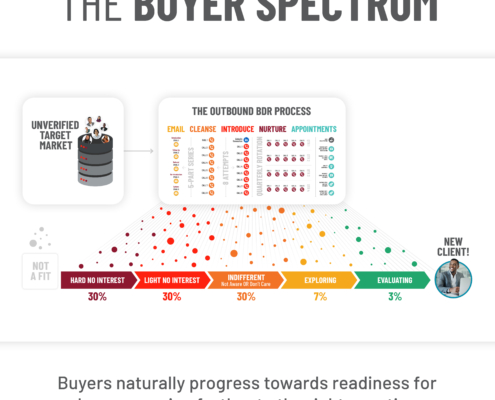

We’ve all sat through a bad presentation. Whether it was a boring college lecture or a bad sales pitch, there’s nothing worse than sitting through a presentation and wishing it would be over already. What’s worse than that, though? Being on the other side of things as a B2B sales rep and constantly facing rejection.
The last thing you want to hear when you’ve worked hard on a B2B presentation is, “Sorry, I’m going to need more time to think this over.” Hearing this over and over again never gets easier. Unfortunately, if your B2B sales pitch deck has too much text, bad content, no images, and no unique differentiators, you probably won’t sell as much as you’d like.
Selling to other businesses isn’t easy. Fortunately, by creating a sales presentation that prioritizes the buyer, you can start delivering killer sales pitches and close more deals. Throughout this blog, we’ll cover the following topics:
Why Preparing a B2B Sales Pitch Deck Is Important
When you prepare a B2B sales pitch deck for your sales meetings, you’re putting the potential customer at the core focus of the conversation. Rather than having a general presentation, preparing a pitch deck customized for that specific prospect is vital because it encourages them to envision themselves in the shoes of your customer.
What To Include in a Sales Presentation
We know your business has a lot to offer prospective companies, but you don’t want to overwhelm them with an abundance of information all at once. Here is a slide-by-slide guide on what should be included in a sales presentation:
Slide 1: Presentation Overview
Start your presentation by listing the key points that will be discussed in the meeting. Giving the potential customer an agenda maps things out clearly and eases them into the presentation.
Slide 2: Identify the Problem
A key component of every sales presentation should be to speak to a pain point. If you know your ideal customer (you should if you’re in B2B sales), then you already know their pain points and understand why they may need your products or services. Use this to your advantage. Identify a problem, use statistics to back up your statements, and use the issue to lead into your value proposition.
Slide 3: Company Introduction
It’s essential to start your presentation by telling the audience more about your company. You can’t just jump right into the pitch without telling them a little about your history, who you are, and what you’re about. This slide gives them a reason to listen to you and trust what you have to offer.
Slide 4: Why Us?
Before diving right into products or services, you should next incorporate a “Why Us?” slide. Sure, you may offer a solution to a problem, but why should a customer want to work with you? What makes you unique? What value do you offer? This slide helps customers understand why they should work with you instead of a competitor.
Slide 5: Products/Services
Any B2B sales presentation must include one to three slides talking about products or services. Obviously, the whole point is to sell your offering, so you’ll want to highlight this more than anything. Clearly explain what your product or service offering entails, but keep it short and sweet. Use bullet points, include imagery when possible, and don’t clutter slides with text.
Slide 6: Meet the Team
If you’re selling a service rather than a product, it’s a good idea to include a “Meet the Team” slide. Showing a customer the team they’ll be working with should they sign on with you helps them better picture themselves as your partner.
Slide 7: Process and Pricing Information
If you’re selling a service, clearly explain to the customer what the implementation or onboarding process looks like. It’s likely that things aren’t going to go from 0 to 100 in the blink of an eye. Usually, there is a process in place for how a new client is brought on as a customer. Tell them what this looks like, what the pricing options are, and what they can expect next.
Slide 8: Conclusion and Next Steps
Be sure to keep it short and sweet and quickly wrap up key points in the last few minutes of your presentation. Your final slide should clearly define the next steps and segue into the next phase of the partnership. Whether this means a second meeting, a phone call, or a follow-up email recapping the pitch, make sure you have a plan for the next step. Also, make sure that you’ve answered all questions before ending any sales pitch.
Need help building a sales presentation that converts? Discover how the design experts at Abstrakt approach building high-quality sales presentation decks.

How To Make a Sales Presentation That Converts
While anyone can just whip up a sales presentation on PowerPoint or Google Slides, it takes a sales-driven marketing person to craft a pitch deck that converts opportunities into customers. If you want to make a sales presentation that concerts, it’s important that you do the following:
Understand the Wants and Needs of the Buyer
The first step to developing a killer sales presentation is understanding your target audience. If you don’t take this into consideration, your whole pitch will be off. According to Forrester Research’s Buyer Insight study, only 13% of customers believe salespeople can demonstrate an understanding of their business challenges and how to solve them. The buyer must come first.
Before you even start building your sales presentation, define your who and how. Who are you pitching to, and how will you solve a problem their business currently faces? When you understand your ideal customer perfectly, you can better tailor your message to that audience.
So, before you make a pitch deck, first identify who you are pitching to and ask yourself:
- What are their main pain points?
- Who are their customers?
- What solutions or products are they currently using?
Once you identify your who, determine how you are going to solve their problems.
- What’s in it for them?
- How can you solve a problem they currently have?
- What makes you better than the competition?
Answering these questions before creating a pitch deck will help you target your message to your ideal customer and make each pitch you deliver that much better.
For insight into how you can effectively identify the needs of your target market, read our blog here.
Highlight Your Core Company Differentiators
One of the keys to a great sales presentation is to not clutter your slides with too much text. Every slide should have a good mix of text and images. Also, make sure the colors, fonts, and visual elements in your presentation match your branding.
Build Credibility With Case Studies and Statistics
There are two ways to spice up your sales presentation: case studies and powerful statistics. Even a customer who has agreed to a meeting with you is still going to have their doubts. This is why you have to build credibility and show the customer why you’re a company that can be trusted.
Case studies show potential customers the success that you’ve had with businesses that are similar to theirs. This helps the potential customer visualize themselves using your products or services. Additionally, a powerful statistic can be what converts someone from a potential customer to a long-term partner. This shows the customer your value and why they should work with you and your company.
Case studies play a significant role in lead generation. Learn how to use case studies to your advantage here.
Practice Your Pitch—Don’t Memorize It
Once you feel like your pitch deck is complete, it’s important to practice it. This doesn’t mean memorizing each slide word for word but instead delivering your pitch in a way that feels natural. Use slides to guide your thoughts and words instead of using them as a script. Preparation is the key to a great sales presentation, but this means to practice, not memorize. Make sure you’re comfortable with the material and develop the confidence to give the presentation without even looking at the slides. This will result in a natural sales pitch and a more engaging conversation with the potential customer.
Consistently Ask Buyer-Focused Questions
If you’re the only one talking during your sales pitch, you’ll quickly bore your audience and lose their attention. Engage the prospect by asking questions and letting them talk. Asking questions not only helps you keep your audience on their toes, but it also helps you as the B2B sales rep. It will make your follow-ups much more effective, because asking questions will help you better understand your customer’s business. Don’t read through your presentation like a robot, engage the customer and create conversation throughout the entire pitch.
Asking prospects questions during a sales meeting opens up the floor for conversation rather than talking at them the whole time. Here are some example questions to ask potential buyers:
- What are you hoping to accomplish with your business within the next year?
- What are your must-haves, should-haves, and could-haves?
- How do you go about reevaluating your current solution?
- What is a priority for you right now?
- When are you looking to make a change to your existing solution?
- Why are you looking at other opportunities?
- Where do you see your biggest opportunities for growth?
Define the Next Steps
Even if you’ve delivered the perfect B2B sales pitch about your company and your products or services, your job isn’t done. Once you’ve informed the customer, you need to outline the next steps for them. The entire point of a B2B sales presentation is to hopefully convince an interested customer to purchase your product or service. If they’re not 100% clear on how to make a purchase, you’re likely not going to sell to them. Make the next steps clear. What actions do they need to take? What will the beginning of your partnership look like? What results can they expect to see? In addition, if the customer isn’t quite ready to buy at that moment, be sure to schedule a follow-up phone call or appointment.
Nurture Relationships With Qualified Prospects
Lead nurturing is the process of building top-of-mind awareness and nurturing relationships with leads in the sales pipeline until they’re ready to buy. Without a lead nurturing process, you risk missing out on high-quality business opportunities.
One of the biggest problems many sales teams face with lead nurturing is that they don’t know how to do it to their advantage. When nurturing leads in the sales pipeline, it’s essential to use various communication channels to engage with key decision-makers, including making warm calls, sending them relevant email marketing collateral, and engaging with them on social media. If you emphasize one lead nurturing tactic over another, you could risk turning off the lead from ever doing business with your company.
Lead nurturing may be an essential component to building your sales pipeline, but it’s important to understand when your lead generation efforts may be too much for potential buyers. The goal with lead nurturing is to be professionally persistent without scaring them off. While you may want them to sign on with your business, it’s important to be considerate of their time and inbox because sending too much content too frequently can easily turn them off from your business.
While it may be beneficial to take advantage of all the different lead nurturing methods, your relationship-building efforts must align with the buyer persona of your target market. For instance, if you analyze your sales enablement program and see that most sales appointments come from email, then focus your nurturing efforts on sending high-quality email marketing materials rather than consistently making warm phone calls.
Additionally, just because email marketing lead nurturing campaigns work best for your target market now, this may not always be the case. When practicing lead nurturing, it’s essential to routinely analyze your sales enablement program and see what leads are more receptive to. Then you can adjust your sales enablement strategy as it seems fit.
Key Takeaways
While there are many ways to approach B2B sales presentations, some methods are much more effective and memorable than others. A sales presentation could be what does or doesn’t convert a lead into a loyal customer.
If you need help perfecting your B2B sales presentation, contact a rep at Abstrakt Marketing Group and learn how we’ve helped other businesses create their B2B sales presentations!




